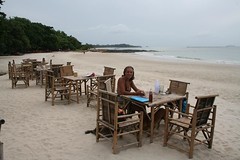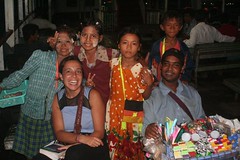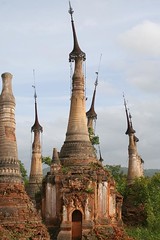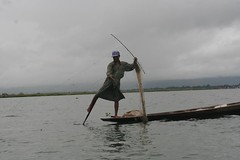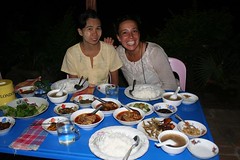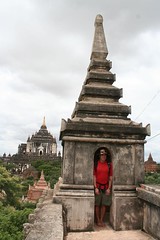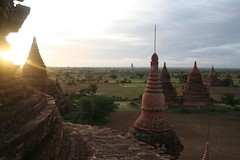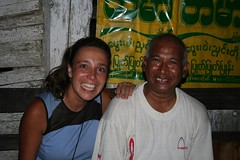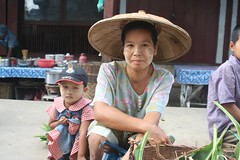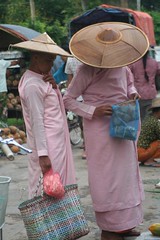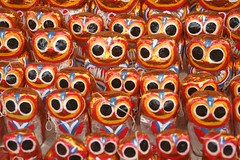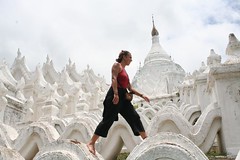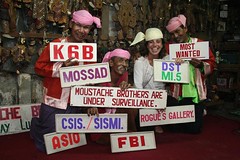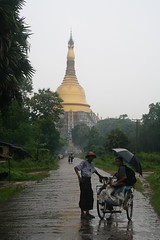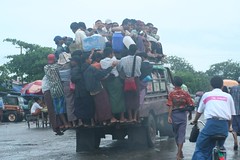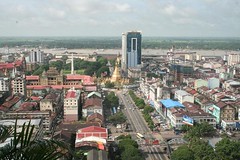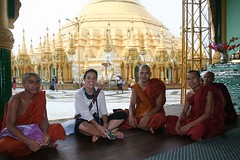
(Formerly Mush and Stub's World Tour) - Travel tips, advice and adventure stories from our World Travels since 2001. Over 65 countries and counting. Click on the links at each entry to see more photos in Flickr.
Tuesday, July 25, 2006
Tub Tim's on Koh Samet , Thailand
When we arrived back in Bangkok from Myanmar, we really felt like we needed some beach time to finish off our trip. After some gift shopping at the massive Chatuchak market with friends Scott and Nina, we decided to visit another friend Paul in Jom Tien Beach, near Pattaya. Now Pattaya is the sex capital of the biggest sex industry country in SE Asia. A place we had absolutely no intention of going to on our trip, but wanted to visit Paul who was finishing off his diving instructors course there. He did take us on a whirlwind tour of the famous 'Walking Street', complete with pubs, go go bars, strip clubs, and toy bar (full of lady boys). After one night walking 'the street', it was time to get to a proper beach!!!
Local buses to the pier of Ranong, where we took a rough boat ride over to Koh Samet, the first island we visited in Asia 11 months ago. We knew where we wanted to go, and made our way to a beach front bungalow on Ao Phudsa, and quickly went to our favourite restaurant - Tub Tim - to get some BBQ squid and relax on the beach.
As you can imagine, our last few days were spent totally relaxing and eating. Quick swims to cool off, sitting on our sarongs on the beach watching the crabs dig holes and ball up the sand, eating some of the local seafood, and enjoying some drinks at sunset whilst relaxing on the comfortable triangle cushions at the bars.
Then it was back to Bangkok for some last minute shopping and sending some packages and just enjoying Bangkok for what it is. Michelle flew back to England a few days earlier than me, to make it for her Mum's birthday. I stayed around and enjoyed time with our local friends and even got treated to a dinner out with our travel agent of the last 11 months, Mr Thai and his brother. It was a really nice send off!! *Stub
Friday, July 21, 2006
Goodbye Burma!
With great sadness it was time to say farewell to Burma with its lovely people and many beautiful sights. We were going to miss its quirkiness with its kids on the street wanting photo after photo, people talking about Rooney as soon as you say you're English, women spitting red betel nut juice from the bus, being jammed elbow to elbow on trucks with the locals, seeing major car repairs performed on the side of the road, watching the sport of chinlone, changing money on the black market, traveling in trishaws and horse carts, having clean toilets (yes, way more cleaner than any we saw in China!!). We most certainly were going to miss the people with their happy welcoming demeanour and their great sense of humour. We loved the places we visited too - the spectacular and immense ruins of Bagan, the tranquility of Inle Lake. The capital Yangon (formerly Rangoon) was busy and chaotic, while in Mandalay we got templed-out amongst the greenery.
There are very strong views on both sides of the fence about visiting Burma - within the country itself and overseas. Due to the dictatorial government many areas are still off-bounds to tourists, and prices are artificially high in the more controlled areas where the $$ go almost straight to the government. For us, we thought long and hard about coming to Burma because of this and certainly we tried to minimise any benefit to the government by avoiding government-run transport, staying in de-regularised guesthouses, and buying food at local restaurants and on the streets. Infact our Bangkok Airways flight back to Bangkok got cancelled and instead of taking Myanmars Airways - the Government airline - we insisted on waiting 3 more hours to take Thai Airways. I wonder if avoiding countries unfortunate enough to be ruled by such dictatorships helps anyone. If anything, we are definitely less ignorant and we hope to promote awareness of Burma's plight generally, aswell as to people in office. Burma is a great country with amazing people, and we are certainly glad we went. We wished we had had more energy and time though, and given the chance we would go back tomorrow. It was a wonderful experience. *Mush
Thursday, July 20, 2006
Local Street Bar, Yangon, Myanmar
After our great time in Inle Lake, we hopped on another internal flight and we were back where we started - Yangon. This visit was a little more casual, and we found that we spent a lot of time shopping for gifts in the amazingly huge and cheap Bogyoke Aung Sun Market, along with the myriad of stalls and vendors along the local streets. We did find time to stop for a drink along the way at a pretty typical street side eatery - I love the chair hanging from the awning. At one street vendor, I managed to have a bird crap in my meal from a bridge above!
We had planned to take the Circle Train around the town. It is just a local train, not for tourists, but apparently it was a good way to see the real life of Yangon. Unfortunately, we really got screwed around trying to buy tickets and eventually got sent on the wrong train by the conductor. He was trying to do us a favour as the Circle Train was not due to run until later, but we were upset as he should have just told us. We did still manage to meet some great kids on the train, and see what strange things the locals were selling. Pretty uncomfortable seats though - just wooden planks. Great city life views from the windows, but we saw the same things twice as our train was an out-and-return train.
We managed to bump into a British lady, Mandy, who we met in Inle Lake. She was on a business trip and treated us to drinks at her hotel later - sweet! On our final morning, we rode the elevator up to the 11th floor of the Sakura Tower for amazing views over Yangon. We wished we had been there for drinks the night before. *Stub
Tuesday, July 18, 2006
Wonky Stupas of Indein, Inle Lake, Myanmar
A long tail boat is essentially a long open canoe-shaped boat with a loud car engine stuck on the back with a prop-shaft and propellor protruding out a long way before touching the water. We had seen many of these before in Asia especially in Thailand, and it was in this that we enjoyed a long day trip across Inle Lake. It was a busy day and we saw lots of lake life - many amazing stilt houses and villages, floating gardens of tomatoes, lots of cargo of rice and veggies being shipped around to markets, and of course, fishermen doing their weird foot paddle. We went to a local market that wasn't too touristy. It sold everyday household items and homemade foods and veggies. The local people here were different and wore bright red towels wrapped around their heads. We were amazed at how many local crafts and trades they had as we jetted through the canals to silk and cotton weaving factories, black smiths, cheroot cigar rolling factories, printing presses and silver jewelry makers. We topped off our day with a trip to Indein - a popular spot with tourists and of course, souvenir sellers. We were lucky though, because since it was late afternoon, most of the stalls that line the path up to the top 9that seemed like miles) were all empty! Phew! At least that wouldn't ruin our visit (as we had heard from others) and it was one hassle were glad to have missed. The atmosphere of Indein is surreal, with its crumbly, wonky stupas (pointy monuments), and overgrown temple and paths. We even saw trees growing out of the tops of some stupas! There was even this UFO type bug that had clear circular wings and a glowing gold body underneath. It was seriously cool and we wished we had more time.
On the ride back across the lake, we took time to stop at the Nga Hpe Chaung Monastery, also known to foreigners as Jumping Cat Monastery. I guess monks get bored too, and these monks had taught their cats to jump through hoops placed about 1m (3 ft) above their heads. Weird but interesting. *Mush
Monday, July 17, 2006
Leg Rowing Fisherman, Inle Lake, Myanmar
Time to say goodbye to the jewels of Bagan, and we departed for the airport in our most different taxi yet - a horse drawn cart. Cool. Next stop: Inle Lake, and immediately we met a couple of other travellers - Burak and Seb from Turkey, to share one of our most expensive taxis yet from the airport. Inle Lake had an nice relaxed feel to it - lots of life on the water. Floating villages, houses on stilts, fishermen paddling in a unique way with their leg (as in the photo), freeing up their arms to put out traps or string out nets - I cannot believe they are able to balance on one leg on the end of a canoe! We took a canoe ride through some of the smaller canals amongst the reeds and watched how local life went -children hanging out by the water, playing football, feeding pigs, mothers doing laundry and dishes, people washing themselves etc etc. Along with it though there were lots of hellos and big smiles.
We met a few travellers in our guesthouse - some of them we'd met before in other places on the road, and we all ended up going to a small pizza restaurant called Min Min's. Well, Min Min's apparently had only been open for 2 months, and Min Min himself was a modest and generous (!) man - and very proud of his new brick pizza oven!! The pasta was good and eventually, when we tried it, his pizza was great, but the main attraction were his cheap and excellent cocktails! Capirinhas and Mohitos were just 80 cents (40p), and after a few very generous ones we were definitely all quite merry. The next morning most of us had stories to tell of either some drinking injury, getting lost on the way home, or feeling very ill with even a few of us throwing up! But it was an excellent night out. * Mush
Saturday, July 15, 2006
Traditional Feast with Aye Aye Mar, Bagan, Myanmar
One of the local people we met during our time in Bagan was Aye Aye Mar (or we called her Emma). Whilst touring through the spectacular Ananda Pahto, we came across some vendors selling bamboo plates. The plates were made from circled bamboo strips, then lacquered with different colours. Emma was by far, the nicest lady of all the sellers and actually gave us a decent first price. So many vendors we encounter just ask for ridiculously high prices for their goods, and we don't even bother bargaining with them. But Emma was different. Her English was not too bad and we formed a nice rapport with her. It was a fun experience buying from her and we loved the quality of her things, so much so, that we returned to her the next day to buy some more. She even got her husband to deliver the plates to our hotel 4 km away on his motorbike with their son carrying the plates sitting on the back, just so we didn't have to carry them on our bicycles.
I think we spent a total of $17 USD on the plates, and as we were leaving her stall the second time, she called us back and asked us to dinner. How nice is that? We couldn't turn down the offer even though we were supposed to meet other friends for dinner. So, she took us to her friend's restaurant and provided us with an absolute feast of curries and sauces. Check out how many bowls are on the table. Of course, as soon as one bowl was looking low, her friend would top it up, so at the end it looked like we hadn't touched anything! Emma's English was not bad, so we had a good conversation at dinner and then came dessert. Michelle and I absolutely loved a sugary, fudge like substance called jaggery. It was made from plums! So tasty, she actually bought us some to take with us. At the end of dinner, she refused to let us pay and she spent probably about $3USD on us. Considering they don't make much money, this was a huge treat taking us out. She was an absolutely lovely lady, and is typical of the type of amazing people we met in Burma. *Stub
Friday, July 14, 2006
Tiny Doorways of Shwegugyi Paya, Bagan, Myanmar
This temple is in the heart of Old Bagan. We have heard about a horrible story of how the government approached the villagers of Old Bagan and demanded that they move within 48 hrs, to a 'new' Bagan nearby. The locals were given no compensation for the loss of property and land, and nothing to set up their new home. That's just how the government treats the people here. I'm surprised they are able to smile anymore!
More proof of the horrible, destructive government of Myanmar. This excerpt taken from Wikipedia "UNESCO has unsuccessfully tried to designate Bagan as a World Heritage Site. The military junta (SPDC) has haphazardly restored ancient stupas, temples and buildings, ignoring original architectural styles and using modern materials that bear no resemblance to the original designs. Likewise, the junta is planning to construct a golf course, a paved highway, and a 61-metre (200-ft) watchtower, which is believed to be completed by 2007."
The hideous watchtower has been built and is in use. It does not resemble any of the architecture in the area and is a complete eyesore. Of course, the government pockets the money from any tourist climbing up the tower. So, don't climb the tower if you go! *Stub
Sparkling Sunrise in Bagan, Myanmar
As we had lost a few valuable days while I was layed up sick in the room at Hsipaw, we had some catching up to do. We decided to do a few internal flights to make up the time. The first flight from Mandalay put us in Bagan, a famous area because of the sheer number of temples/pagodas/stupas all in a 41 sq. km area. There are varying numbers, but I have heard 3000, 4000 and 5000 ancient and new temples scattered across the plains. Of course, they all vary in size and shape from tiny little points to massive temples with gold topped roofs, and impressive Buddha statues lining the interiors. Most of the temples were built in the 1000's to 1200's, but there are still new temples being built today.
It is a rather surreal place to catch a sunrise. We would ride bikes to our favourite temple #394, also called Buledi, and relax with this scene as the sun rose over the pointed pagodas. To add to the peacefulness of the scene, we were the only ones there! We could stay there for hours, resting, reading and catching up on the journal.
After enjoying the tranquil morning, we would take on the heat of the day, and ride from temple to temple down the dirt roads between. Some amazing temples, from the gold topped Ananda Pahto, the largest temple Dhammayangyi, and the Indian style Mahabodhi to mention only a few. There were a some sites that had some secret entrances, that you could climb up tight little stairways and reach the rooftop for wonderful views - of course, difficult to find. We would eat at local little restaurants scattered throughout the temple areas and interact with the lovely locals. And of course, finish with a beautiful sunset on a temple, overlooking the Ayeyarwaddy River beyond all the stupas. Quite a special couple of days. *Stub
Thursday, July 13, 2006
Mr. Book, Hsipaw, Myanmar
Another extraordinary character I met was an Australian lady called Maureen. She has been in Myanmar for several years and married a local upstanding man in Hsipaw. He was apparently a highly influential man in the community and without reason was arrested and jailed. She is still awaiting his return. Throughout our travels in Myanmar we hear many stories like this of how the goverment treats their people so atrociously. It's heart breaking and makes us ever more eager to support the local people and tell the world of their plight. *Mush
Wednesday, July 12, 2006
Michelle's New Hat, Hsipaw, Myanmar
The World Cup final was on while we were in Hsipaw, and it seemed that the whole town had turned out to watch it at the local cinema where it was being played - at 1AM. It was an interesting experience especially with the locals spitting out remnants of sunflower seeds, and red betel nut juice all over the floor and seeing red streams of it pass by your feet - pretty gross. They are really into their football here and as Italy and France battled it out on our big screen the Burmese jeered and cheered, until it seemed someone was very happy with the result- they must have bet on France!
While Martin was ill, I explored town and the outer villages by bicycle with an Ozzie couple staying at our hotel. The village kids were as usual very excited about having their photo taken and then seeing it afterwards on the digitial screen. In town I searched for a local traditional hat and couldn't find one with character, so with lots of sign language and pointing I bought a hat straight off a lady's head selling mushrooms and vegetables on the side of the street near the market. It was perfect: well worn-in with lots of character. I offered her the equivalent of 50cents and she seemed happy until she saw other notes that I pulled out of my purse - and by pointing to these she got an extra 10cents! * Mush
Tuesday, July 11, 2006
Buddhist Nuns, Hsipaw, Burma
A 4 hour drive east of Mandalay is the town of Hsipaw (pronounced Sipaw). We shared Muireann's taxi again (she had hired one at the start of her trip) and stopped at a couple of places on the way... Pyin U Lwin, a cool Muslim town with old colourful horse drawn stage coaches for taxis. Another stop at Buddha Cave was a big mistake on our driver's part, as it was the start of Buddhist lent and the 2 mile road leading up to the carpark was absolutely choc-a-bloc with trucks and vans jammed full of people. Sitting in traffic was not enjoyable, so we got out and walked. We never got to see the cave as we lost Muireann and waited at the entrance for her so that we wouldn't miss her... We didn't mind too much as the best bit was walking along the road with the crowds and waving hello, 'talking' to all the people stuck waiting.
Hsipaw itself is a small riverside town known for its relaxing atmosphere and walks/hikes into the lush countryside. A boat ride and hike took us through pineapple and papaya plantations to different villages and monasteries where we got some great pics of young monks and locals. Unfortunately, it was unbearably hot and Martin later started suffering from heat exhaustion. Not very pleasant especially as the hotel was choosing to conserve electricity (it is low season here) and there were no fans or aircon for about half the day and night! Add to that a bout of food poisoning and he really wasn't well for a number of days.
Hsipaw's main attractions are its two markets: the one that starts at 4am(!) - the veg and produce market called the candle-light market; the second, is the day market selling food and everyday housewares and hardware. And that's it! One morning at 6am while Martin was ill I went to market and although I've seen more exciting markets before, it was a great time to be out and I loved watching lots of young novice monks collecting alms (food donations and money) (double click the pic for pics of these). Two Buddhist nuns dressed in pink were also out, shopping for herbs and veggies. Loved the shape of their hats. * Mush
Sunday, July 09, 2006
They're Watching You: Lucky Owls, Mandalay, Burma
We took a day trip out of Mandalay with Muireann and Matthew visiting Sagaing, Inwa and Amarapura - three different areas teeming with temples. It was a full day! In Sagaing we saw many of them and climbed the hills to see many more stupas and temples dotted throughout the rolling green landscape. At the temples it was crazy and there was souvenir stand after souvenir stand with an occasional one selling Buddhisty stuff - everything from incense sticks and Buddha figures, to these lucky owls made of papier mache. They were very cute sitting row upon row, wide-eyed, side by side. We couldn't resist getting a couple of small ones for our Xmas tree (when we get one). We'll see if they make it home in one piece!
By the end of the day we were pretty 'templed' out! At Amarapura we watched many monks crossing its famous U Bein bridge over large Taungthaman lake - the longest teak bridge in the world, about 1 mile long (1.2km) with 600 teak supports. These were leftover from the Palace at Inwa when it got moved to Mandalay. In Inwa we had to catch a small boat to get to the temples and the only way to get around was by horse cart. We were not happy at this as it was quite expensive (even though we bargained them down), but we had no other choice... Still, it was a nice afternoon inspite of a storm and pelting rain. * Mush
Saturday, July 08, 2006
Chinlone Festival, Mandalay, Myanmar
After a long day, we made a stop at Mahamuni Paya on our way home and discovered the Chinlone Festival. Chinlone is a sport that is played with a wicker-type ball and seems to be the national sport of Myanmar. It is however, not a sport so much as a demonstration as only one team plays at one time. There is usually one player in the middle doing a multitude of tricks, with the rest of the team just keeping the ball in play after different moves. The centre player is switched at times, so more than one player is the focus. The best players had money pinned to their backs, apparently tips from the audience.
Apparently we arrived at a good time as this young boy is one of the best known chinlone players in the country. He was simply amazing and could control that little ball unbelievably. It is hard to describe some of the moves he was capable of. Apparently there are over 100 named moves that are appreciated more when repeated. Here he is kicking the ball up with his left foot(only about 12 inches high), and circling his foot over the ball before quickly kicking it up again. He could do this move about 100 times in a row if he wanted. He also would do some weird no look hits off his knee tucked under his opposite shoulder over and over - can you picture it??? I didn't think so, that is why I said it is hard to explain. Check out http://www.chinlone.com/ to find out more about the amazing sport.
It was a treat to watch these guys and sit around the circle with the local men and many monks in attendance. Michelle and our Irish friend Muireann were the only women in attendance! *Stub
Friday, July 07, 2006
Hsimbyume Paya, Mingun, Myanmar
We attempted to bus up to Inle Lake, but the buses were full, so we caught an overnighter all the way up to Mandalay, changing our planned route slightly. After taking one of the tiny blue Mazda Pick-up truck taxis from the bus station to find a hotel, we started to explore Mandalay. After lunch, the rains started to slow down and we walked to the Palace with a new Aussie friend Matthew. The Palace itself is surrounded by a huge moat, probably around 2 miles on each side. The palace has recently been restored with forced labour from the locals. A truth we are getting too familiar with. The palace was called the Glass Palace because of the small pieces of mirror decorating the outside. The structure however is wooden and painted red and yellow - quite beautiful really.
On our first full day in Mandalay, we walked to the Ayeyarwaddy river and promptly caught a boat upriver to Mingun Paya. The stupa at Mingun was slated to be the largest in the world at 150m (492 ft), and still would have been today. But alas, King Bodawpaya died in 1819, and work ceased on the structure, leaving the largest pile of bricks I have ever seen. The base built entirely of brick was complete, but a recent earthquake has produced several large crack in the brick structure. There is also the Mingun bell, the worlds largest, undamaged bell weighing in at a cool 90 tons nearby. You are able to climb up the steps to the top of the base, for great views of the area and Ayeryawaddy River. You can also see Hsimbyume Paya from the top.
We recognized Hsimbyume from somewhere...... oh yeah - the cover of the Lonely Planet Myanmar. So Michelle, taking the place of a young novice monk in a red robe, recreated the step across the arches to give our version of the picture. Check out this link to compare:
*Stub
Thursday, July 06, 2006
The Moustache Brothers, Mandalay, Myanmar
While in Mandalay, we saw a couple of evening shows. On our first night, we visited the local garage of the Moustache Brothers. About 10 years ago, they were visited by a Lonely Planet writer, who enjoyed the show and wrote them up in the 'travelers bible'. So, now most foreign visitors to Mandalay who own a Lonely Planet go to see this show. It was their meal ticket for sure!
Now for some history on the show. Apparently, the repressive Myanmar Government banned the Moustache Brothers from performing in public to local people because of some political jokes they told. Brother #1 Par Par Ley (RHS) was actually jailed 7 years for telling jokes (there is actually a reference to this in the Hugh Grant movie 'About A Boy'). Ridiculous you might say, but that is how things are in Myanmar. So, the brothers went underground somewhat, and out of their garage they still perform the show to foreigners (apparently there is no ban on this.....yet!). So, they make jokes about how they are 'under surveillance' and hold up signs of all the different countries' secret agencies with photos of their customers!
The show itself was interesting. Brother #3 (Middle) was the MC and he was quite hilarious. He uses all the slangs of so many countries, and although it was sometimes quite hard to understand his English, he even spelt it out for us! They put on demonstrations of different costumes, local clothing, local dances with the help of wives and sisters, and local music. A good night out if you find yourself in Mandalay, and don't worry if you can't quite find the right garage, they will find you! *Stub
Tuesday, July 04, 2006
Rainy Trishaw Tour with Sammy and Tin, Bago, Myanmar
Upon our arrival to Bago, 2 hours North of Yangon, we were greeted by Sammy and Tin, who were local trishaw drivers. Trishaws are bicycles with eassentially a side car attached with one seat facing forward and one backwards. They assured us that they would be able to take us around most of the sights of Bago in the afternoon, despite the pelting rain. So we agreed to pay them the 3000 kyats ($2.50, £1.50) for the afternoon, and they started peddling us around. We tried to use our umbrellas to keep them dry, but after a while it was a lost cause. The streets were a swamp and the locals took to using canoes to transport people through the lower level streets.
First stop was visiting the happy cheeroot (cigar) rollers. They spend at least 10 hours a day rolling about a thousand cigars, all for about $1 pay. There were even some young kids there (3-4yrs) helping their mothers out, and one was using a pair of huge scissors that were bigger than he was!!!
As for the temples: if you hadn't guessed it yet, there are probably millions of temples in Myanmar - even more than other countries we had visited. We were able to avoid the $10 government fee, by waiting until the ticket checkers had left for the day. This allowed us to 'help' out Sammy and Tin with a little extra money that went directly to them and not the government. Bago had some wonderful temples and 90 m tall stupas, with the highlight being the 61m long reclining Buddha of Shwethalyuang. It is housed in a large building to protect it, but walking up to it, all you can see is a huge wall of torso, only to reveal the massive length of the Buddha at the end of the hallway. It's head was resting on some very ornamental pillows and the soles of its feet were elaborately decorated. Even it's baby finger was over 3m long. We visited more temples for the rest of the day, finishing with the tallest at sunset. Although the rain was still falling, the bright gold made for a neat contrast with the strange blue of the sky (double click for pic on Flickr).
We thoroughly enjoyed our day out, but mostly because of the drivers. Such nice men, and we were able to really 'talk' to them. There are so many things that locals won't and aren't allowed to talk about, but they seemed to open up to us a little. Recommendations to anyone heading to Bago! An excellent afternoon. *Stub
Monday, July 03, 2006
A Typical Bus Heading for Twante, Myanmar
Across the river by ferry, we managed to get inside one of these buses which are basically big pick-up trucks with narrow lengthwise bench seats. These buses DO NOT leave until full - including the rooftop!!! Little did we know that when full, not only do the people climb up on the roof, they then hang off the back - I think about 20 people were holding on for their lives on the tailgate as the bus tanked along. It was a fun ride inside jammed elbow to elbow with all the curious locals. 1 hour later we were in the small town of Twante (pronounced 'Twanty').
Greeted by more torrential rain, we were led to a local joint for a bite to eat, and then perused the market. I guess they don't see a lot of Westerners there, and were very curious about us, staring intently. Friendly though, as we had become used to in Myanmar. Of course, the market was filled with many strange and colourful sights, but not quite as smelly as many other markets we had been in. For the tourists, a local highlight is visiting the pottery shacks just on the outskirts of town. Using our newly purchased umbrellas, we strolled through the puddle-ridden streets to these thatched shacks and enjoyed watching one lady spinning the pottery wheel by hand, while the man molded a large pot on it in less than a minute! All the time, we had their kids jumping around us, wanting photos taken of course. Walking back to catch our bus kids were playing in the rain and deep puddles everywhere. Our journey back was another overloaded bus back to the river where we had fun on the ferry with the local vendors carrying their trays of things to sell - mostly kids sent out to make extra cash for the family. They were funny as they pretty much forgot about selling the gum and trinkets and were more interested in having their photos taken. An exhilarating and soggy day. *Stub
Formerly Rangoon, Burma
Anyway, had a great first few days here. People are very friendly and we are pretty much celebrities, even though foreignors do come here. Burma was an English colony up until 1948, but people's English is still surprisingly good - even the younger generations'. It is raining season here too - pretty much raining all afternoon and evening which means we have to get up and out before 9am. It's the type of rain that's warm and refreshing, but soaks you in about 3 seconds flat! Possibly our best investment yet - we bought a couple of umbrellas!
Yangon, formerly called Rangoon during colonial times, is a multi-ethnic, frenetic city with lots of crumbling colonial buildings, gold glittering stupas, treacherous (for me, anyway!) wonky-slabbed pavements (sidewalks), and streets teeming with people, and markets with vendors and food stalls. Changing money is interesting here: since the government charges a tax for every transaction, you get more for your US$ on the black market - normally from touts on the streets or at the local tourist market. The men wear a sarong-type skirt called a Longyi, made out of a tube-shaped piece of fabric which they wrap around and tie in a knot at the belly. Business men dress a little smarter and usually sport a crisp white shirt with their longyi! Women and children wear a strange kind of face makeup called thanakha - a cakey creamy yellow that hardens and apparently protects them from the sun - even though there's only rain at the moment! * Mush
Sunday, July 02, 2006
Sule Paya in Downtown Yangon, Myanmar
After a short flight from Bangkok, we were in Yangon (formerly Rangoon), Myanmar (formerly Burma). Things are different here. A very cool mix of cultures and people with smiling faces wherever you look. Unbelievable considering how badly they are treated by the repressive government.
They don't call it rainy season for nothing as we were greeted by torrential rain everyday. Sometimes the mornings would only be light rain, but by the afternoon, streets would be flooded and we were unable to ever get dry. So, we had to continue being tourists in the rain, because if we didn't, we wouldn't see anything!
The first thing you notice downtown is the main traffic circle, encompassing a huge, 2000 year old stupa called Sule Paya. Around the stupa are many colonial buildings from the British occupation up until the 50's. There is also a huge market area called Bogyoke Aung San, which houses loads of little shops and is also where we would get our US money exchanged to Myanmar kyat on the black market. All around the market, people would sneak up to you and ask if you want to change money. A little sly, but the only way to do it here as the 'official' rate of exchange is around 6 kyat to $1, where on the black market, you get 1300 kyat to $1. Not sure how that all works, all I know is I need to carry around huge stacks of 1000 kyat bills as that is the highest denomination they have. *Stub
Saturday, July 01, 2006
Chatting with the Monks at Shwedagon Paya, Yangon, Myanmar
Our time in Myanmar/Burma was special. We hadn't planned to visit Myanmar on our trip, but too many people recommended it, so we squeezed it in at the end. Unfortunately, we only had 3 weeks and there is plenty to see in quite a diverse country. We were also quite tired after 13 months on the road, that we felt we weren't as adventurous as if we had visited earlier. Oh well, all good reason to return!
This photo is at Shwedagon Paya, the most sacred and impressive pagoda in the former capital of Yangon. It is over 100m tall, and is up on a local hill. The massive gold stupa has 4 long entrances, each from the cardinal points, with gold roofs and guarded by 2 huge chinthe (half lion, half dragon) statues. Around the main stupa were loads of other temples, some for each day of the week. In their culture, it is important which day of the week you were born, and you pray to that specific temple. Strangely, there are 8 temples, and so they divide Wednesday into AM and PM to create the 8 'days'. Just as we arrived, the skies opened up and the rains came. Loads of umbrellas, and some very slippery tiled floors circling the stupa.
It is typical of our time in Myanmar, as while we were waiting out the heavy rains, a group of monks came to talk to us. Their English was excellent, so they really didn't need to work on it, but just hung out with us for an hour learning about our lives and what we do. The people here are so curious about the 'outside' world because they are only told what the government tells them. They are genuinely friendly and our time in Myanmar was so good because of the people. Always greeted with a big smile and a friendly 'Minglava' (hello in Burmese). *Stub


